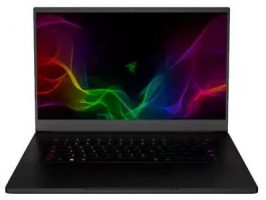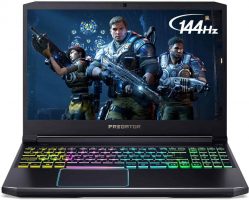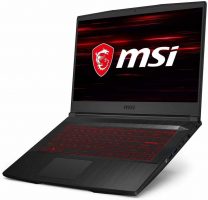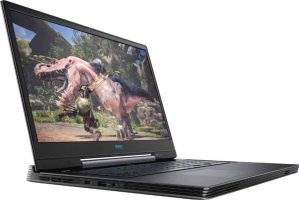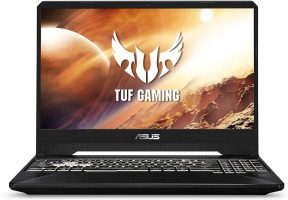Best Gaming Laptop Under $1500 in 2021
Excellent gaming performance at a budget-friendly price
- Last Updated May 27, 2021
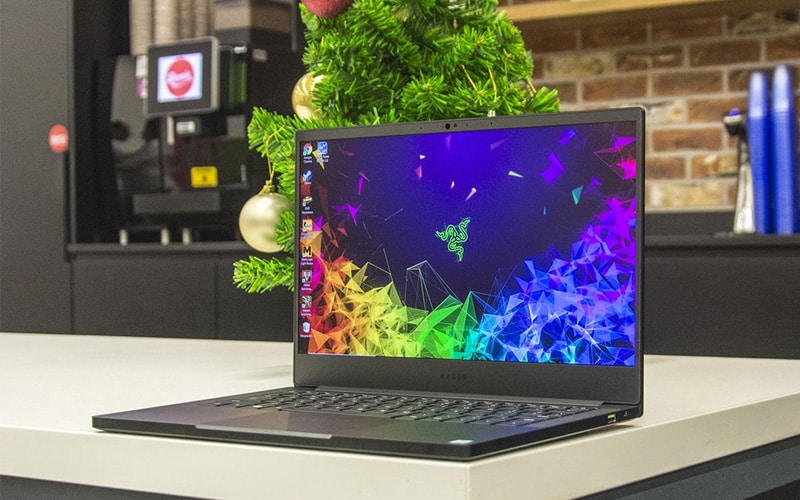
Not long ago, gaming laptops were shunned by desktop purists as inferior, lower spec, and expensive substitutes for the real thing. Many of the arguments against gaming laptops no longer hold water like they once did.
They no longer command such an exorbitant price – while you still pay a premium for portability and the very best in compact thermals and battery life, they are more affordable than ever, and the gap to desktop PCs is reducing each year. They sport the best and latest components, with virtually the same CPU-GPU pairing options as desktop gaming PCs, and deliver a genuinely premium gaming experience on the go.
There’s arguably never been a better time to invest in a gaming laptop, especially as they represent a sure-fire way to avoid the great GPU drought and get your hands on one of the elusive NVIDIA GeForce RTX 30-series and Radeon RX 6000-series cards.
Your budget largely dictates what blend of GPU, CPU, RAM, storage, and display you’ll find in a gaming laptop. Today, we’re honing in on the best options priced under $1,500, more than enough to deliver a top gaming experience in a form factor small enough to fit inside a backpack.
Products at a Glance
How We Picked
With more gaming laptops than ever, we had our work cut out narrowing down our recommendations. When we set out to choose the best gaming laptops under $1,500, we focused on several key factors to steer our time with a dizzying number of laptops: specifications (CPU, RAM, storage, etc.), performance, chassis quality and design, display size/resolution and refresh rate, and battery life/efficiency. More importantly, in the context of laptops fit for gaming, we prioritized the GPU.
Below, you’ll find five gaming laptop recommendations that offer a potent gaming-centric mix of performance and hardware, all for under $1,500. We’ve separated them into different categories to highlight their best attributes. We’ve also tried to offer options that deftly handle today’s biggest games and house enough power to set you up for the future to a certain extent.
Of course, we’ve only scratched the surface of what’s out there. A $1,500 budget means we had to make some cuts and omit some equally excellent portable gaming powerhouses, so no hard feelings if your top choice hasn’t made the list.
Read on for a whistle-stop review of each alongside quick pros and cons for those that prefer a bite-sized overview.
Best Gaming Laptop Under $1500 in 2021
8th Gen Intel Core i7-8750H 6 core processor
16G memory size
15.6” 144Hz Full HD edge-to-edge display (4.9mm bezels)
DDR SDRAM
NVIDIA GeForce RTX 2060
Intel Core i7-10750H
Gaming performance
Superb design and construction
Middling battery life
Razer is synonymous with gaming laptops, and with good reason, as the company systematically teeters on the cutting-edge of portable gaming technology, not least with its much-loved Razer Blade product line.
The latest iteration of the Razer Blade 15 features NVIDIA’s new RTX 3000-Series GPUs, and the price has surged accordingly, unfortunately beyond the $1,500 cap. But, it’s not all bad news, as prices of comparatively lower specced 2020 versions sporting Turing RTX 2000-series GPUs have dropped. Consequently, a decked-out 2020 Razer Blade 15 now sells for below $1,500. And, boy, do you get value for your money.
An NVIDIA GeForce RTX 2060 with 6GB GDDR6 and six-core 2.6 GHz/5.0 GHz Intel Core i7-10750H combo propose a strong foundation that, when paired with 16 GB of DDR4 2933 MHz RAM, 512 GB NMVe SSD, WiFi 6, and a generous smattering of I/O ports, stacks up to specifications with enough juice to power virtually any game under the sun with high frame rates at 1080p and with ray tracing to boot.
This particular configuration ships with a 15.6-inch Full HD 144 Hz display, a sturdy precision-crafted aluminum chassis, slim (only 0.7-inches thick) and refined constructions free of gaudy ‘gamer’ flourishes, and Chroma RGB keyboard backlighting. Despite the small footprint, the Razer Blade 15 has cooling covered with a bespoke heat pipe system, custom 44 blade fans, and the use of top-quality thermal materials.
The only real complaint we can level at the Razer Blade 15 is mediocre battery life. Not surprising for such powerful hardware and, to a certain extent, comes with the territory, so not a real concern for most.
NVIDIA GeForce RTX 2070 Max-Q
Smooth 240 Hz display
Excellent gaming performance
One button overclocking
Unwieldy design
Loud fans
Mediocre battery life
In the $1,500 price range, the Acer Predator Helios 300 is top of the class in gaming performance and even slightly bests the Razer Blade 15 due to housing a better GPU, the NVIDIA GeForce RTX 2070 Max-Q with 8 GB GDDR6. It’s hard to differentiate the two because the specifications are virtually identical, but, in our estimation, the Blade 15 takes the top spot for the more refined design and slimmer profile.
A well-rounded selection of other components complements the Acer Predator Helios 300’s GPU: Intel Core i7-10750H CPU, 16 GB of 2933 MHz DDR4 RAM, 512 GB NVMe SSD (as well as an open M.2 slot if you fancy popping in an extra SSD), four-zone RGB backlit keyboard (the keyboard also features a Tap Turbo for instant overclocking), Wi-Fi 6, Gigabit Ethernet, and plenty of display/USB ports. The Acer Predator Helios 300 also ups the stakes with a fantastic 15.6-inch Full HD IPS display with 3 ms response time and ultra-smooth 240 Hz refresh rate.
The Acer Predator Helios 300’s custom-engineered cooling setup leans on a pair of ultra-thin serrated blade 4th Gen Aeroblade 3D fans that do well to keep the temperatures in check. While these fans work well as an efficient salve to curb high temperatures, they fall flat on the noise front and churn out quite the din under high loads, especially when the Predator CoolBoost feature springs to life.
Another potentially negative is that the Acer Predator Helios 300 incorporates some sharp and uncomfortable edges and unwieldy design that’s reminiscent of gaming laptops of old. The chassis is considerably larger than the Razer option. However, the construction is on point and feels just as sturdy. While an improvement on previous Helios models, the battery is mediocre, and you’d be lucky to pull off any more than four to five hours of gaming away from the charger.
144 Hz refresh rate
NVIDIA GeForce RTX 3060 Price
Strong gaming performance
Plastic chassis
Noisy cooling
Lackluster display
With the release of the NVIDIA GeForce RTX 30-series GPUs, we’re seeing manufacturers update their gaming laptop line-ups accordingly. Among them, the MSI GF65 is one of the more interesting in that it doesn’t saddle you with too many subpar components to make up for including one of the latest GPUs.
Under the hood, the MSI GF65 features an NVIDIA GeForce RTX 3060, Intel Core i7-10750H, 15.6-inch FullHD 144 Hz IPS display, 16 GB of DDR 4 3200 MHz RAM, 512 GB NVMe SSD, Wi-Fi 6, backlit keyboard, and a decent spread of USB, display, and audio ports.
On paper, the specifications are excellent for the sub $1,500 price point, but in practice, the MSI GF65’s gaming performance lags behind other RTX 3000-series-equipped laptops. These other gaming laptops do cost considerably more, so it’s a reasonable compromise to make.
MSI has also cut corners in other respects, chiefly a lackluster display, plastic chassis, and loud fans. Nevertheless, pure performance is better than what you’d get from a last-gen NVIDIA GPU, which is precisely what MSI aims to achieve with the MSI GF65. If you’re comfortable with these compromises, then this one’s an affordable way to get in on the next-gen NVIDIA GPUs, especially as their dedicated iterations for desktop PCs are nigh on impossible to buy.
17.3-inch 144 Hz display
NVIDIA GeForce RTX 2060
Solid gaming performance
Bulky
Runs hot
17-inch gaming laptops tend to command a premium for the extra on-screen real estate, but Dell has successfully dropped the price below $1,500 with the Dell G7 while offering some impressive specifications.
The star of the show is, of course, the 17-inch IPS Full HD panel with a 144 Hz refresh rate and 9 ms response time. Alongside, you’ll find a well-rounded set of components: Intel Core i7-10750H, NVIDIA GeForce RTX 2060 with 6GB GDDR6, 16 GB of DDR4 2933 MHz RAM, a 512 GB NVMe SSD, nine I/O ports (USB, SD card, MiniDP 1.4, HDMI 2.0, Ethernet, and audio), Wi-Fi 6, Gigabit Ethernet, four-zone backlit keyboard, and customizable chassis RGB.
The Dell G7 confidently tackles most modern AAA games at 1080p with respectable frame rates. While an improvement on previous G7 models, the design remains bulky and may not suit those that prefer a more unstated look. It also runs quite hot despite an engineered dual-fan cooling system.
120 Hz display
AMD Ryzen 7 3750H
NVIDIA GeForce RTX 2060
Decent gaming performance
Noisy fans
High temperatures can cause throttling under the heaviest loads
Cheap plastic chassis
If you’d rather go for an AMD CPU to bring the cost down even further, the ASUS TUF Gaming FX505 is worth considering.
Specifications tally up to the following: NVIDIA GeForce RTX 2060, AMD Ryzen 7 3750H, 16 GB of DDR4 1866 MHz RAM, 512 GB SSD, Gigabit Ethernet, RGB backlit keyboard, and a 15.6-inch FullHD 120 Hz IPS panel. Gaming performance is respectable at 1080p, and the 120 Hz refresh rate offers a smooth, responsive experience.
It has its faults – mainly a shoddy plastic chassis, loud fans, and high temperatures can cause throttling under the heaviest loads – but for roughly $1000, we have here a genuine bargain, and the corners cut are understandable at this price point. The deluge of new RTX 3000-series laptops means we’re likely to see the price drop even further on this one, ideal for anyone with modest gaming needs and who doesn’t care about following the latest trends.
Things To Consider
Our Verdict
8th Gen Intel Core i7-8750H 6 core processor
16G memory size
15.6” 144Hz Full HD edge-to-edge display (4.9mm bezels)
DDR SDRAM
With a well-deserved reputation as the best-in-class gaming laptop, the Razer Blade 15 gaming laptop tops our recommendations for the best portable gaming rigs priced under $1,500. With good specifications, impressive gaming performance, and superb design and construction, the Blade 15 is the complete package.
Similarly impressive is the Acer Predator Helios 300 for its excellent gaming performance, attractive spec-sheet, and buttery smooth 240 Hz display. It’s not perfect, but at the $1,500 price point, there’s little out there to best this splendid gaming laptop.
Among the more budget-oriented RTX 3000-series gaming laptops, the MSI GF65 represents the best bang for your buck with stacked specifications for the price, strong gaming chops, and some reasonable compromises to keep costs to under $1,500.
For a more immersive gaming experience under $1,500, we recommend the 17-inch Dell G7. Finally, for those that prefer an AMD CPU, we recommend the ASUS TUF Gaming FX505. The lowest price of our picks, it may fall behind in gaming performance but packs in tons of value for the price.
With that, we’ll bring our guide to the best gaming laptops under $1,500 to a close. Feel free to get in touch via the comments section below with any questions or recommendations of your own.

